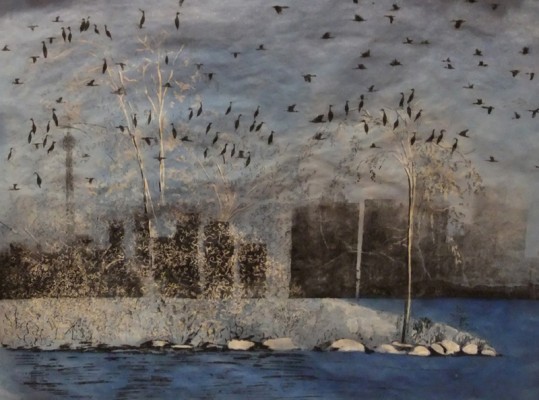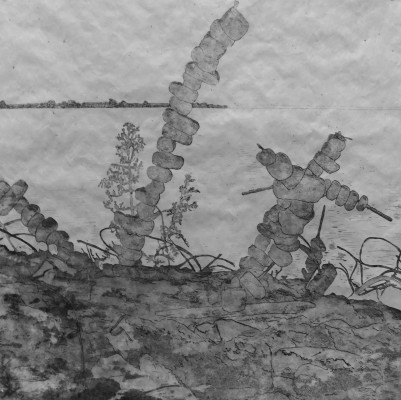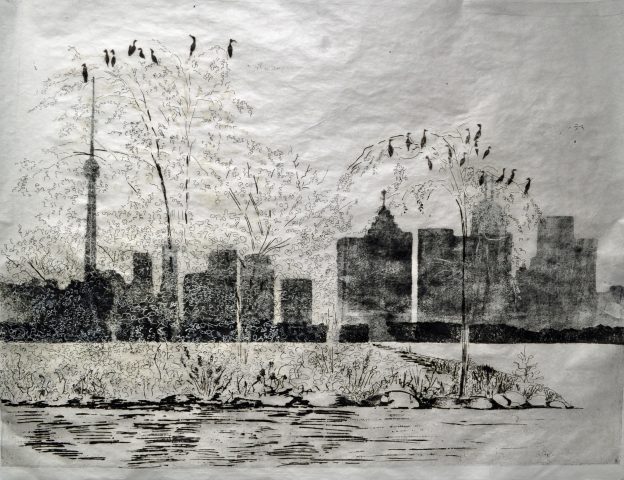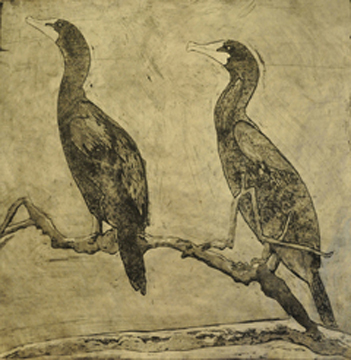Wasteland and The City
The Leslie Street Spit: Wasteland to urban wilderness to wasteland
Last summer, I visited the Leslie Street Spit: an urban wasteland that has come full circle. With delight, I found a tranquil marshy inlet teeming with plant and animal life. In a meadow, I found wildflowers, butterflies and songbirds.
Next, I found a Double-crested Cormorant colony – aptly described by Leslie Scrivener as “a wintry apocalypse”(May 20, 2009, Toronto Star). The sight, smell and sound of thousands of Cormorants perched and flying around denuded trees was incredible. With the City of Toronto as a backdrop, I saw a wintry apocalyptic wasteland.
Started in 1959 as a landfill for construction waste, fill, and material dredged from the City of Toronto’s harbour, the Leslie Street Spit grew into a lush, fertile, and vibrant urban wilderness treasure.

More than 400 plants, 314 birds, 19 mammal and 12 herpetile species have been found there. (Double-crested Cormorants at Tommy Thompson Park Backgrounder, Toronto and Region Conservation Authority, TRAC, p.1).
Endangered species like Black-crowned Night-Herons and Double-crested Cormorants began populating the spit. Due in part to the nesting colonies of Double-crested Cormorants, the spit (Tommy Thompson Park) was designated a globally significant Important Bird Area by Nature Canada and Bird Studies Canada. (TRAC, p.1) The waste land had become an urban wilderness treasure.

Ironically, the landfill that became an urban wilderness is being turned back into a wasteland by nature. Cormorants have stripped the trees of bark and twigs for their nests. Cormorant guano has coated the trunks and branches of the trees and changed the chemistry of the soil so that nothing can grow. Guano has turned everything a ghostly white. Stands of trees are dead or dying. Habitat for other species is being lost and the area has become vulnerable to colonization by non-native, invasive species. (TRAC Backgrounder, p.2)
Cormorants, which now number around 30,000, threaten other species. Black-crowned Night Heron colony has been forced into marginalized breeding areas and their numbers are declining. (TRAC Backgrounder, p.2) Concerns have been raised with respect to the health of the colonies of waterbirds like the Ring-billed Gull, Caspian Tern, Herring Gull, and Great Egret. (TRAC Backgrounder, p.2) Fish stocks are declining. The urban wilderness treasure areas that are home to the cormorant colonies have become a wasteland.
How should the Cormorant population be managed? Culling Cormorants (shooting), oiling eggs, scarring them with noisemakers, and forcing them to nest on the ground are set out as possible solutions. The emphasis of the City of Toronto and Region Conservation Authority Master Plan is to “adopt an ecological approach that relies on natural processes, augmented by minimal intervention and management to achieve a greater diversity of community types”(TRAC Backgrounder, p.2). Ainslie Willcock, of Cormorant Defenders International notes: “The Toronto Regional Conservation Authority (TRAC) has chosen a responsible and thoughtful approach to managing the colony”(p.1). Scrivener states that others, while they support the conservation authority have noted: “Will someone please stand up and ask, why don’t trees count? What about the songbirds?”(p.1)
In The Waste Land, T.S Eliot refers to the Wood Thrush, a songbird. To me, the Wood Thrush is a harbinger of good luck and a symbol of hope. Wood Thrush, as well as Blackburnian Warblers and Kingfishers, have been sighted on the Spit.
Further along the Spit, far past where the city remains in view, I saw wonderful sculptures made from found materials – weather and water-worn construction debris, such as bricks, concrete blocks and rebar.

These new sculptures created from worn, old, found materials bring hope. They serve as a reminder that out of chaos comes creativity.


